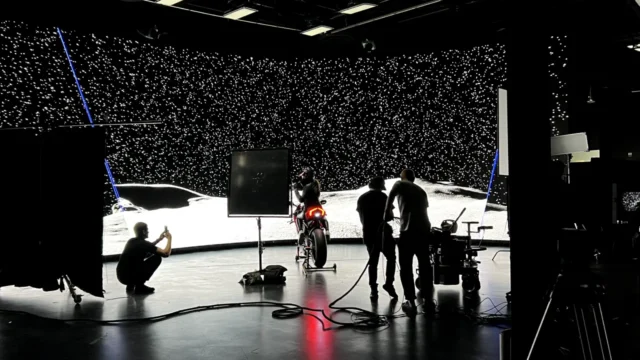Virtual production has transformed the filmmaking industry, blending real-time computer graphics with live-action footage to create immersive, dynamic environments. At the heart of this revolution lies the Virtual Production Camera Tracking System, a critical technology that ensures seamless integration of virtual and physical worlds. By precisely tracking camera movements in real time, these systems enable filmmakers to craft stunning visuals with unprecedented efficiency and creativity. Among the leaders in this space is ARwall, a pioneering company whose innovative solutions are making virtual production accessible to creators of all levels. In this guest post, we’ll explore the significance of camera tracking systems in virtual production, their key features, and how ARwall is redefining the industry with its cutting-edge technology.
What is a Virtual Production Camera Tracking System?
A Virtual Production Camera Tracking System is a sophisticated setup that tracks the position, orientation, and movement of a camera in real time, syncing physical camera movements with virtual environments. This technology ensures that digital backgrounds, set extensions, and CGI elements align perfectly with live-action footage, creating a cohesive final image directly in-camera. By eliminating the need for extensive post-production compositing, these systems save time and reduce costs while empowering directors and cinematographers to visualize the final shot on set.
Camera tracking systems rely on a combination of hardware and software, including sensors, markers, or markerless tracking technologies like Visual SLAM (Simultaneous Localization and Mapping). They are versatile, supporting various production environments such as LED walls, green screens, and augmented reality (AR) setups. From blockbuster films to independent projects, these systems are revolutionizing how stories are told.
Why Camera Tracking Systems Matter in Virtual Production
The rise of virtual production has been driven by its ability to streamline workflows and enhance creative control. Camera tracking systems are the backbone of this process, offering several key benefits:
- Real-Time Visualization: Camera tracking allows filmmakers to see the final composite of live-action and virtual elements in real time, enabling immediate creative decisions.
- Cost Efficiency: By delivering final-pixel results on set, these systems reduce the need for costly post-production fixes, saving both time and budget.
- Creative Freedom: Directors and cinematographers can experiment with camera angles and movements without worrying about misaligned virtual elements.
- Versatility: Modern systems support a range of setups, from small-scale green screen shoots to massive LED volumes, making them adaptable to various production scales.
- Precision and Accuracy: Advanced tracking technologies ensure sub-millimeter accuracy, ensuring seamless integration of virtual and physical environments.
These advantages have made camera tracking systems indispensable for modern filmmaking, with companies like ARwall leading the charge in making this technology accessible and user-friendly.
ARwall: Pioneering Accessible Virtual Production
Founded with a mission to democratize virtual production, ARwall (arwall.co) has emerged as a top player in the industry, offering award-winning solutions that cater to filmmakers of all budget levels. With over eight years of experience and more than 120 XR (extended reality) virtual production deployments, ARwall combines innovative software, hardware, and production services to deliver turnkey solutions for creators. Their flagship product, the ARFX Pro Plugin, integrates seamlessly with Unreal Engine, providing filmmakers with intuitive tools for real-time in-camera visual effects (ICVFX).
ARwall’s approach is built on accessibility, scalability, and simplicity. Their systems scale from smartphone-based tracking for indie filmmakers to advanced setups like the VIVE Mars CamTrack for large-scale productions. By prioritizing user-friendly interfaces and plug-and-play solutions, ARwall ensures that creators can focus on storytelling rather than technical complexities. Their recent innovations, such as the Infinite Studio with AI-generated environments, showcase their commitment to pushing the boundaries of virtual production.
Key Features of ARwall’s Camera Tracking Systems
ARwall’s camera tracking solutions, including the VIVE Mars CamTrack, stand out for their precision, ease of use, and affordability. Here are some of their standout features:
- Markerless Tracking with VIVE Mars CamTrack: Using HTC Vive’s technology, ARwall’s system offers accurate tracking with a setup time of just 10-20 minutes, ideal for fast-paced shoots. It supports large tracking areas (up to 10m x 10m) with minimal hardware, requiring only two base stations for basic setups.
- ARFX Pro Plugin: This professional-grade plugin integrates with Unreal Engine, offering tools for real-time rendering, lens emulation, and creative control. The intuitive ARFX Options Menu allows filmmakers to adjust virtual environments without exiting play mode, streamlining on-set workflows.
- Smartphone-Based Tracking: For budget-conscious creators, ARwall’s ARFX app enables camera tracking using just an iPhone, either as a standalone recording device or mounted to a professional camera. This scalability makes virtual production accessible to independent filmmakers.
- AI-Driven Infinite Studio: ARwall’s latest innovation uses AI to generate virtual environments in hours rather than months, complete with depth maps that respond to camera movements. This feature is a game-changer for rapid pre-production and creative exploration.
- Cost Savings: By leveraging in-camera XR technology, ARwall has helped productions like Nightflyers achieve savings of 62-73% per episode compared to traditional green screen VFX.
These features make ARwall a go-to choice for filmmakers seeking reliable, high-quality camera tracking solutions that don’t break the bank.
Comparing Camera Tracking Technologies
Camera tracking systems come in various forms, each with its strengths and trade-offs. Understanding these options is crucial for choosing the right system for a production.
Optical vs. Mechanical Tracking
- Optical Tracking: Uses cameras, reflective markers, or markerless technologies like Visual SLAM to track movement. Optical systems, like Sony’s OCELLUS or ARwall’s VIVE Mars CamTrack, are versatile and often more affordable but may require controlled environments to avoid reflections.
- Mechanical Tracking: Relies on physical components like motors and encoders for high accuracy. Systems like EZtrack’s Hub are ideal for complex setups but are more expensive and less portable.
ARwall’s optical tracking solutions, particularly the VIVE Mars CamTrack, strike a balance between affordability and precision, making them suitable for a wide range of productions.
, such as the VIVE Mars CamTrack, offer a cost-effective alternative to mechanical systems, with quick setup times and compatibility with Unreal Engine.
Marker-Based vs. Markerless Tracking
- Marker-Based Tracking: Uses physical markers (e.g., reflective spheres or IR LEDs) for stable, high-precision tracking. OptiTrack’s CinePuck, for example, excels in controlled studio environments but requires longer setup times for marker placement.
- Markerless Tracking: Relies on Visual SLAM or sensor-based technologies to map environments in real time, eliminating the need for markers. Sony’s OCELLUS and ARwall’s solutions shine here, offering flexibility for outdoor or dynamic shoots.
ARwall’s markerless tracking with VIVE Mars CamTrack simplifies setup while maintaining accuracy, making it a top choice for filmmakers who need portability and ease of use.
Integration with Rendering Engines
Most modern camera tracking systems, including ARwall’s, integrate with 3D rendering engines like Unreal Engine to deliver real-time visuals. ARwall’s ARFX Pro Plugin enhances this integration with features like lens emulation and customizable XR environments, ensuring seamless workflows from previs to final shoot.
The Future of Camera Tracking in Virtual Production
As virtual production continues to evolve, camera tracking systems are becoming more sophisticated and accessible. Emerging trends include:
- AI Integration: ARwall’s Infinite Studio demonstrates how AI can compress pre-production timelines by generating dynamic environments with depth maps, allowing for rapid set creation.
- Portability and Scalability: Systems like ARwall’s smartphone-based tracking and Sony prerogative solutions like Sony’s OCELLUS are making professional-grade tracking accessible to smaller productions.
- Markerless Advancements: Advances in Visual SLAM and hybrid tracking technologies are reducing reliance on markers, enabling more flexible workflows in diverse environments.
- Cost Reduction: Companies like ARwall are driving down costs, making virtual production viable for independent filmmakers and smaller studios.
These trends point to a future where virtual production is no longer the domain of big-budget studios but a tool for creators at all levels.
Case Study: ARwall in Action
ARwall’s impact on virtual production is evident in projects like the Crossfire Sierra Squad Live Action Trailer, where their in-camera XR technology blended live-action footage with game assets to create immersive battle scenes. By using the ARFX Pro Plugin and VIVE Mars CamTrack, the production team achieved precise camera tracking and real-time compositing, resulting in a seamless final product without extensive post-production. This project highlights ARwall’s ability to deliver high-quality results efficiently, even for complex, action-heavy scenes.
Choosing the Right Camera Tracking System
Selecting a camera tracking system depends on several factors:
- Production Scale: Large LED volume shoots may require high-precision systems like OptiTrack, while smaller productions can leverage ARwall’s smartphone-based or VIVE Mars CamTrack solutions.
- Environment: Markerless systems like ARwall’s are ideal for dynamic or outdoor settings, while marker-based systems suit controlled studio environments.
- Budget: ARwall’s scalable solutions cater to a range of budgets, from affordable smartphone tracking to professional-grade setups.
- Ease of Use: Systems with intuitive interfaces, like ARwall’s ARFX Pro, reduce the learning curve for new users.
For filmmakers seeking a balance of affordability, precision, and ease of use, ARwall’s solutions are hard to beat.
Conclusion
Virtual production camera tracking systems are reshaping the filmmaking landscape, offering unprecedented creative control and efficiency. ARwall stands out as a leader in this space, providing accessible, scalable, and innovative solutions that empower creators to bring their visions to life. From the VIVE Mars CamTrack to the AI-driven Infinite Studio, ARwall’s technology is making virtual production a reality for filmmakers of all levels. As the industry continues to evolve, ARwall’s commitment to accessibility and cutting-edge innovation positions it at the forefront of the virtual production revolution.
Visit arwall.co to learn more about how ARwall can transform your next project with their award-winning virtual production solutions.








[…] in a lifetime experience is how i would classify a visit to a speakeasy. Cocktails during such ocassions are also bycicle rides around the world, so […]